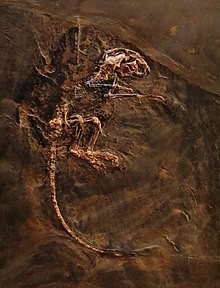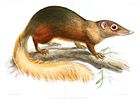Apatemyidae
| Apatemyidae Temporal range:
| |
|---|---|

| |
| Heterohyus nanus | |
| Scientific classification | |
| Domain: | Eukaryota |
| Kingdom: | Animalia |
| Phylum: | Chordata |
| Class: | Mammalia |
| Superorder: | Euarchontoglires(?) |
| Order: | †Apatotheria Scott & Jepsen, 1936 |
| Family: | †Apatemyidae Matthew, 1909 |
| Genera[2] | |
Apatemyidaeis an extinctfamilyofplacental mammalsthat took part in the first placentalevolutionary radiationtogether with other early mammals, such as theleptictids.Their relationships to other mammal groups are controversial; a 2010 study found them to be basal members ofEuarchontoglires.[3]
Common in North America during thePaleocene,they are also represented in Europe by the genusJepsenella.[4]
Apatemyids in life
[edit]Like most Paleocene mammals, the apatemyids were small and presumably insectivorous. Size ranged from that of adormouseto a large rat. The toes were slender and well clawed, and the family were probably mainly arboreal.[5]The skull was fairly massive compared to the otherwise slender skeleton, and the front teeth were long and hooked, resembling those of the modernaye-aye,both whom make their living by gnawing off bark with their front teeth to get at grubs and maggots beneath.[6]
References
[edit]- ^Lopatin, A. V.; Averianov, A. O. (2021). "First Apatemyid Mammal from Central Asia".Journal of Mammalian Evolution.doi:10.1007/s10914-021-09574-5.
- ^Solé, F.; De Bast, E.; Legendre, H.; Rana, R. S.; Kumar, K.; Rose, K. D.; Smith, T. (2020). "New Specimens ofFrugivastodon(Mammalia: Apatotheria) from the Early Eocene of India Confirm Its Apatemyid Status and Elucidate Dispersal of Apatemyidae ".Biological Consequences of Plate Tectonics:279–304.doi:10.1007/978-3-030-49753-8_12.
- ^Silcox, M. T.; Bloch, J. I.; Boyer, D. M.; Houde, P. (2010)."Cranial anatomy of Paleocene and EoceneLabidolemur kayi(Mammalia: Apatotheria), and the relationships of the Apatemyidae to other mammals ".Zoological Journal of the Linnean Society.160(4): 773–825.doi:10.1111/j.1096-3642.2009.00614.x.
- ^Agusti, J.; Anton, M. (2002).Mammoths, Sabertooths, and Hominids: 65 Million Years of Mammalian Evolution in Europe.Columbia University Press.ISBN0-231-11640-3.
- ^von Koenigswald, W.; Storch, G., eds. (1998).Messel: ein Pompeji der Paläontologie.Sigmaringen: Thorbecke.ISBN3-7995-9083-8.
- ^v. Koenigswald, W.; Schierning, H.-P. (9 April 1987). "The ecological niche of an extinct group of mammals, the early Tertiary apatemyids".Nature.326(6113): 595–597.doi:10.1038/326595a0.
External links
[edit]





